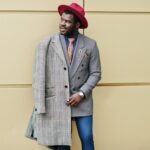
Experts say that the reason there are more plus-size clothes on the market now is because of social and business pressures that are making companies fight for a piece of this $21 billion industry.
Some of the plus-size models who have been on magazine covers are Tara Lynn, Jennie Runk, Ashley Graham, and Chloe Marshall. They show how the fashion business is getting better at making clothes for people of all sizes.
People have never really thought of style, glitz, and fashionable things when they think of the plus-size business. Plus-size clothing is hard to find, and it hasn’t given women much of a chance to look beautiful, sexy, or fun. It’s hard for plus-size women to show how beautiful they are. As many people have said, they should avoid bright colors, stripes, flowers, and fancy fabrics.
On the other hand, “real” fashion showed women in a way that was based on stereotypes and didn’t appeal to most of them. Size 10 models look beautiful on ads and fashion runways, but they don’t reflect real women. Instead, they show an idealized picture of a woman who doesn’t exist. According to the numbers, sizes 14 through 18 are the most popular, not sizes 10 and under.
All plus-size buyers have had the same problems, whether they wear plus, small, junior, or tall sizes. No matter if you’re looking for wholesale big and tall clothing or plus-size clothes, you can find them.
A Business Paradigm
Inclusive sizing is more than just making more sizes available. This is already done by a lot of fashion companies, but not always to the customer’s satisfaction. Inclusive sizing is a company concept that must be used.
First of all, size 18 isn’t the end of what’s included. At the moment, most American women wear a size 16 or 18. Because of this, it’s no longer right to call these sizes “plus.” To be inclusive, a brand must meet the wants of customers who wear a size 24 or bigger. Keep in mind, though, that customers who fit the categories of tiny, junior, and small.
The word “plus” itself can be a source of discrimination, which is another part of the plus-size problem. Many brands’ shopping experiences, ads, and other marketing tools have all helped to make this gap worse.
It’s not a secret that the plus-size parts of physical stores are sometimes hidden away or hard to get to. As if to say that these people are different from everyone else and should be kept separate. Customers don’t want to shop in this kind of way. Even when friends of different sizes go shopping together, everyone will still have a good time if the store has an open-size policy. So, inclusive shops, both in person and online, try to give every customer the same shopping experience, no matter what size they are.
It’s important that websites and marketing tools show people with different body types. In this way, each client will feel like they have a voice. The movie Good American is a great example of this. They show off all of their clothes on three different types of models. This is a more effective way to communicate with their customers because they can see how the item would look on them in sizes 0, 8, and 16.
Where High Fashion Is Going
But there is still one more important thing to think about when it comes to inclusive sizing. In the past, people with curves didn’t have many chances to get what they wanted. Most of the formal clothes that plus-size women wore were dark, boring, and loose. Not at all what you’d expect from a smart, beautiful woman. Inclusion should therefore focus on making high-quality clothes in the same range of styles, ease, and usefulness as other customers, as well as making clothes in bigger sizes.
So, this change in the fashion industry could be the start of the end for exclusive designers, shops, and services for plus-size buyers. Most brands will find it hard to make this change, but it will also give them a lot of chances to grow. Producers will work harder to make sure that their clothes look good on people of all shapes and sizes. Instead of spending money on separate sets for different sizes.
Michael Felice, a principal at A.T. Kearney, says, “Today’s consumers want their trusted brands to define beauty not by size or weight, but by individuality and confidence.” “Customers from Generations Y and Z want to connect with a company in every way. But it’s hard to do that when all the beautiful models showing off the goods only represent a small part of the target market.”
The only way to meet this demand is to change how plus-size clothes are made and make all products bigger than they are now. The models must work well for all sizes, and the cutting must make sure that both small and big people can wear them well. This is a brand-new way for high fashion to go. They can offer more choices to the customer. They don’t have to make different lines for each section because they can make their choices in different sizes and colors.
Businesses That Back “Inclusive Sizing”
In the last few years, this method has already been used by a number of names.
Walmart has been selling plus-size brands for a long time, but it recently added a new Walmart brand for kids and sports. (Time and True, Athletic Works). There are sizes for these things up to XXXL.
Other big businesses that didn’t want to miss out on the opportunities in this area have copied their method. Because of this, stores like H&M, Target, Zalando, Nordstrom, Michael Kors, Calvin Klein, Rachel Pally, and Torrid now have areas for plus-size and petite-size clothing.
A lot of new companies have joined the business by selling wholesale big and tall clothing. This new style has affected not only big brands but also smaller ones and artists. For example, Rihanna’s brand Savage & Fenty focuses on plus-size underwear, which hasn’t been done much before. The company sells both big and small styles of trendy underwear.
These names show how the market is changing right now and how the fashion industry needs to listen to its customers in order to make decisions that really meet their needs.
There is little question that people around the world are learning more about this required market change. Even though many brands are still hesitant to follow this new trend.
How Will Inclusive Sizing Change In The Future?
Statistics from around the world make it clear that fashion companies must now offer sizes that fit more people. Kayla Marci, a market expert at Edited, says that size 14 fits 67% of American women. No matter how they look, all of these women want to wear stylish things. Brands can’t ignore this rule any longer. Sizes that fit everyone are less of a style and more of a necessity for all kinds of products. In most countries around the world, similar facts are the norm.
Many brands will find it hard to change to the new idea of inclusive sizing. But customers are not only ready for these new goods, but they also can’t wait to get their hands on them. Most of the time, they feel like the fashion business hasn’t paid attention to them for too long, so they want to make up for it.
The inclusive size market is an interesting way for fashion brands to make money. It is a worldwide trend that affects every country. And is available for a wide range of people, including women, men, and children.
If you aren’t in the plus business, you don’t have a business.








